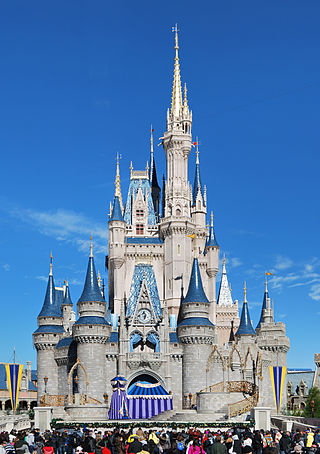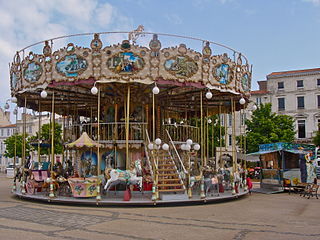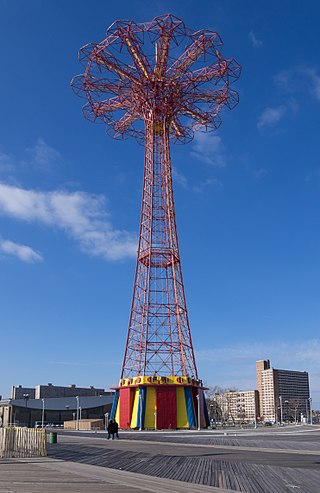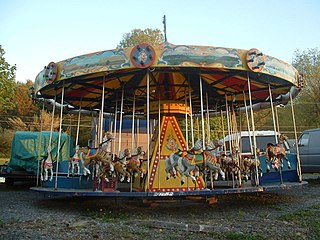
Flushing Meadows–Corona Park, often referred to as Flushing Meadows Park, or simply Flushing Meadows, is a public park in the northern part of Queens, New York City. It is bounded by I-678 on the east, Grand Central Parkway on the west, Flushing Bay on the north, and Union Turnpike on the south. Flushing Meadows–Corona Park is the fourth-largest public park in New York City, with a total area of 897 acres (363 ha).

The 1964–1965 New York World's Fair was a world's fair that held over 140 pavilions and 110 restaurants, representing 80 nations, 24 US states, and over 45 corporations with the goal and the final result of building exhibits or attractions at Flushing Meadows–Corona Park in Queens, New York City. The immense fair covered 646 acres (2.61 km2) on half the park, with numerous pools or fountains, and an amusement park with rides near the lake. However, the fair did not receive official support or approval from the Bureau of International Expositions (BIE).

An amusement park is a park that features various attractions, such as rides and games, as well as other events for entertainment purposes. A theme park is a type of amusement park that bases its structures and attractions around a central theme, often featuring multiple areas with different themes. Unlike temporary and mobile funfairs and carnivals, amusement parks are stationary and built for long-lasting operation. They are more elaborate than city parks and playgrounds, usually providing attractions that cater to a variety of age groups. While amusement parks often contain themed areas, theme parks place a heavier focus with more intricately-designed themes that revolve around a particular subject or group of subjects.

Coney Island is a peninsular neighborhood and entertainment area in the southwestern section of the New York City borough of Brooklyn. The neighborhood is bounded by Brighton Beach and Manhattan Beach to its east, Lower New York Bay to the south and west, and Gravesend to the north and includes the subsection of Sea Gate on its west. More broadly, the Coney Island peninsula consists of Coney Island proper, Brighton Beach, and Manhattan Beach. This was formerly the westernmost of the Outer Barrier islands on the southern shore of Long Island, but in the early 20th century it became a peninsula, connected to the rest of Long Island by land fill.

A carousel or carrousel, merry-go-round (international), roundabout, or hurdy-gurdy is a type of amusement ride consisting of a rotating circular platform with seats for riders. The "seats" are traditionally in the form of rows of wooden horses or other animals mounted on posts, many of which are moved up and down by gears to simulate galloping, to the accompaniment of looped circus music.

Playland, often called Rye Playland and also known as Playland Amusement Park, is an amusement park located in Rye, New York, along the Long Island Sound. Built in 1928, the 280-acre (110 ha) park is owned by the Westchester County government. Beginning with the 2018 season, STANDARD AMUSEMENTS LLC has been contracted to operate the park.

Steeplechase Park was a 15-acre (6.1 ha) amusement park in Coney Island, Brooklyn, New York City. Steeplechase Park was created by entrepreneur George C. Tilyou in 1897 and operated until 1964. It was the first of the three large amusement parks built on Coney Island, the other two being Luna Park (1903) and Dreamland (1904). Of the three, Steeplechase was the longest-lasting, running for 67 years.

Nathan's Famous, Inc. is an American company that operates a chain of fast-food restaurants specializing in hot dogs. The original Nathan's restaurant stands at the corner of Surf and Stillwell Avenues in the Coney Island neighborhood of Brooklyn, New York City. The company's headquarters are at One Jericho Plaza in Jericho, New York, part of Oyster Bay, New York.

The Parachute Jump is a defunct amusement ride and a landmark in the New York City borough of Brooklyn, along the Riegelmann Boardwalk at Coney Island. Situated in Steeplechase Plaza near the B&B Carousell, the structure consists of a 250-foot-tall (76 m), 170-short-ton (150 t) open-frame, steel parachute tower. Twelve cantilever steel arms radiate from the top of the tower; when the ride was in operation, each arm supported a parachute attached to a lift rope and a set of guide cables. Riders were belted into a two-person canvas seat, lifted to the top, and dropped. The parachute and shock absorbers at the bottom would slow their descent.

William F. Mangels (1866–1958) was an amusement manufacturer and inventor. He worked at Coney Island and was a major player in the development of American amusement parks at the start of the 20th century. In addition to manufacturing carousels and inventing rides, including The Whip, he wrote a book titled The Outdoor Amusement Industry: From earliest times to the present (ISBN 0848820029). Mangels is interred at Green-Wood Cemetery in Brooklyn, New York.

The Flushing River, also known as Flushing Creek, is a waterway that flows northward through the borough of Queens in New York City, mostly within Flushing Meadows–Corona Park, emptying into the Flushing Bay and the East River. The river runs through a valley that may have been a larger riverbed before the last Ice Age, and it divides Queens into western and eastern halves. Until the 20th century, the Flushing Creek was fed by three tributaries: Mill Creek and Kissena Creek on the eastern bank, and Horse Brook on the western bank.

Astroland was a 3.1-acre (1.3 ha) amusement park in Coney Island, Brooklyn, New York City that first opened in 1962. It was located at 1000 Surf Avenue on the boardwalk. It ceased operations on September 7, 2008.

Charles I. D. Looff was a German master carver and builder of hand-carved carousels and amusement rides, who immigrated to the United States of America in 1870. Looff built the first carousel at Coney Island in 1876. During his lifetime, he built over 40 carousels, several amusements parks, numerous roller coasters and Ferris wheels, and built California's famous Santa Monica Pier. He became famous for creating the unique Coney Island style of carousel carving.
Rockaways' Playland was an amusement park that operated from 1902 to 1987 in Rockaway Beach in Queens, New York City. Bounded by Beach 97th and Beach 98th Streets between Rockaway Beach Boulevard and the Rockaway Beach and Boardwalk, Rockaways' Playland was created in 1902 by roller coaster designer LaMarcus Adna Thompson. By 1903 a ferry dock was added not far from the park, making it more convenient to reach than some of the competing amusement parks. The park was sold in 1927 to Robert Katlin, who added amenities such as a gym and swimming pool, and the following year to A. Joseph Geist, who achieved greater success than the previous owners. Between 1928 and 1970, Rockaways' Playland was extremely successful, drawing 175 million visitors. It closed in 1987 due to a sharp increase in the price of insurance.

Crescent Park Looff Carousel, also known as Crescent Park Carousel or more officially as Crescent Park Looff Carousel and Shelter Building, is a National Historic Landmark in East Providence, Rhode Island.

Luna Park is an amusement park in Coney Island, Brooklyn, New York City. It opened on May 29, 2010, at the site of Astroland, an amusement park that had been in operation from 1962 to 2008, and Dreamland, which operated at the same site for the 2009 season. It was named after the original 1903 Luna Park which operated until 1944 on a site just north of the current park's 1000 Surf Avenue location.

Marcus Charles Illions was a master carver of wooden carousel horses and other figures at Coney Island, Brooklyn, New York City in the early 20th century. The New York Times referred to him as "the Michelangelo of carousel carvers".
Charles Feltman (1841–1910) was a German-American restaurateur. He is one of several claimed inventors of the hot dog.
Dreamland was an amusement park in Coney Island, Brooklyn, New York City that operated at the site of the defunct Astroland park for the 2009 season. It was replaced with a new Luna Park the following year.

The B&B Carousell is a historic carousel at Coney Island in Brooklyn, New York City. It was built by Coney Island-based manufacturer William F. Mangels c. 1906–1909, with wooden horses carved by Marcus Illions. The carousel has been relocated and refurbished several times over its history. The B&B Carousell has been located in Luna Park since 2013.


























